|
Family: Anatidae (ducks, geese and swans)
Life
> Eukaryotes >
Opisthokonta
> Metazoa (animals) >
Bilateria >
Deuterostomia > Chordata >
Craniata > Vertebrata (vertebrates) > Gnathostomata (jawed
vertebrates) > Teleostomi (teleost fish) > Osteichthyes (bony fish) > Class:
Sarcopterygii (lobe-finned
fish) > Stegocephalia (terrestrial
vertebrates) > Tetrapoda
(four-legged vertebrates) > Reptiliomorpha > Amniota >
Reptilia (reptiles) >
Romeriida > Diapsida > Archosauromorpha > Archosauria >
Dinosauria
(dinosaurs) > Saurischia > Theropoda (bipedal predatory dinosaurs) >
Coelurosauria > Maniraptora > Aves
(birds) > Order: Anseriformes
Species indigenous to southern Africa
|
Oxyura
maccoa (Maccoa duck)
A diving duck with distinctive stiff tail that it either
keeps flat with the water surface or sticks up in the air. It is the
only stiff-tailed duck species in the region. The distribution is
divided between a population in East Africa and the Ethiopian Highlands
and another population within southern Africa, where it is widely
dispersed. They feed mainly on bottom-dwelling invertebrates. |
 |
|
Alopochen
aegyptiaca (Egyptian goose)
A large brown to buff duck, easily
distinguished from other ducks by its large size, the dark brown eye patch
and the brown patch in the middle of the buff-coloured breast. Male and
female look similar but the male is larger; easiest distinguished on the
basis of their call: whereas the male hisses mainly, the female honks
mainly. The Egyptian goose is one of the most commonly encountered birds
in southern Africa, found on wetlands, in croplands and in urban areas. It
is almost exclusively herbivorous feeding on grass, seeds and aquatic
plants.
|
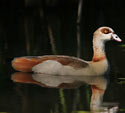
|
|
Tadorna
cana (South African shelduck)
Predominantly light chestnut coloured with a grey head
in the male and a grey head with variable amounts of white in the female. Endemic
to southern Africa, found mainly on waterbodies in semi-arid and grassland
regions. Feeds in the water on aquatic invertebrates and algae, and on
land on grain in crop fields.
|
 |
|
Plectropterus
gambensis (Spur-winged goose)
The
largest duck or goose in Africa, weighing up to 7.45 kg. Widely
distributed in Sub-Saharan Africa and with broad habitat preferences. Eats
mainly plant matter, either from in and around water bodies or on dry land
(seedlings and grain from crop lands are a favourite, which make them
unpopular with farmers) . However, they do eat insects (e.g. termite
alates) and young are known to catch and eat small fish.
|
 |
|
Sarkidiornis
melanotos (Comb duck, Knob-billed duck)
The comb duck is so called because the male has a
round knob on top of the bill, which is particulary prominent in the
breeding season (the word comb can mean the comb you use for your hair but
also has a number of meanings relating to a crest). These large
distinctive ducks are blue-black on the back, white on the front, and the
head is white overlaid by black speckles. In the breeding season, males
hold territories to which they often attract more than one female
(polygynous).
|
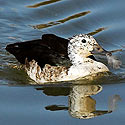 |
|
Nettapus
auritus (African pygmy-goose, Pygmy goose) |
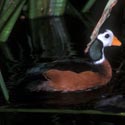 |
|
Netta
erythrophthalma (Southern pochard) The
Southern pochard is common, and has a population scattered across southern
Africa. It lives in wetlands, where it feeds mainly on the seeds and leaves
of aquatic plants. It is a monogamous, solitary nester, the female building
its nest out of leaves and stems, placed on embankments surrounded by dense
vegetation. |
 |
|
Anas acuta
(Northern pintail, Pintail) |
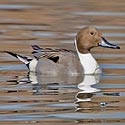 |
|
Anas
capensis (Cape teal) The Cape teal is found mostly in South Africa, where it is
especially abundant in the Western Cape. It prefers to live in salty, brackish vleis,
often with dense reeds, and is also very common in sewerage ponds. It is
nomadic, although it rarely moves more than 250 km. It feeds mainly on
insects, with about a quarter of its diet dedicated to plant matter. The
female builds the nest, which is a shallow bowl in the ground, filled with
aquatic vegetation and feathers.
|
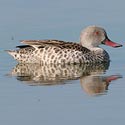 |
|
Anas
clypeata (Northern shoveler, Northern shoveller) |
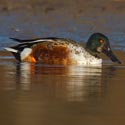 |
| Anas
erythrorhyncha (Red-billed teal) The
Red-billed teal is the most common duck in South Africa, and is also one of
the most common ducks in southern Africa. It lives in inland wetlands,
artificial or natural, breeding in temporary pans and dams. It is nomadic,
rapidly locating new temporary pans and vleis, rarely moving more than 250
km. It feeds mainly on seeds, with smaller quantities of invertebrates. |
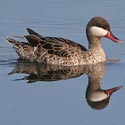 |
|
Anas
hottentota (Hottentot teal) The
Hottentot teal is uncommon to locally common, preferring to live in
permanent, shallow wetlands with tall, emergent vegetation. Its diet varies
greatly with different regions, although it usually it eats more animals
than it does plant matter. Interestingly, the pair bond barely lasts for the
incubation period, after which the female does all the work. |
 |
|
Anas
platyrhynchos (Mallard) |
 |
|
Anas
querquedula (Garganey) |
 |
|
Anas
smithii (Cape shoveler, Cape shoveller) The Cape shoveler is found manly in South Africa, where it
is particularly common in the Western Cape and Kruger National Park. It feeds
mainly on animals, with smaller quantities of plant matter. The female builds
the nest, which is a scrape in the ground, filled with leaves, and completely
surrounded by thick vegetation. It lays 5-13 eggs, which are incubated solely by
the female, for 27-31 days. The chicks are taken care of by their mother, with the male helping by
chasing predators away. The chicks can usually fly at 63 days, after which
they become independent. |

|
|
Anas
sparsa (African black duck) The African
black duck is fairly common in both South Africa and Zimbabwe, with small
populations in other countries in southern Africa. It is a river specialist,
rarely straying away from rivers and streams. Its diet is not well known,
but it is thought to eat more invertebrates than it does plant products. |
 |
|
Anas
undulata (Yellow-billed duck) The
Yellow-billed duck is found mainly in South Africa, where it is very common.
It lives in most types of wetlands, as long as they are still-bodied and not
saline. The adults feed mainly feed on plants, while the juveniles eat
mainly invertebrates. The female builds the nest, which is a shallow
depression in the ground, lined with fine plant matter. It lays 2-10 eggs,
which are incubated solely by the female, for 26-29 days. The chicks are
cared for by their mother, and take their first flight at 68 days old. They
become fully independent 6 weeks after fledging. |

|
Domesticated species

Anser anser (Greylag Goose). |
|
